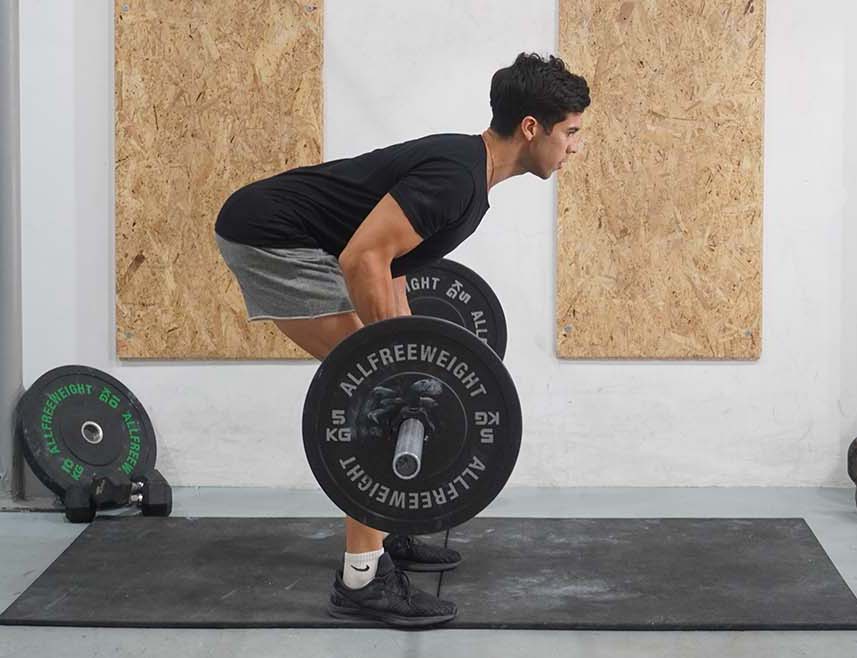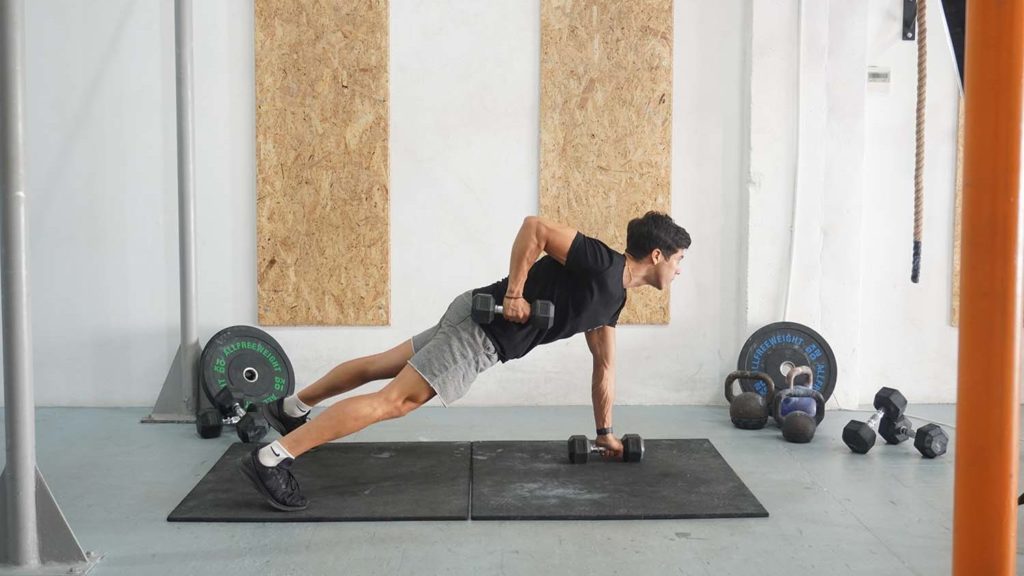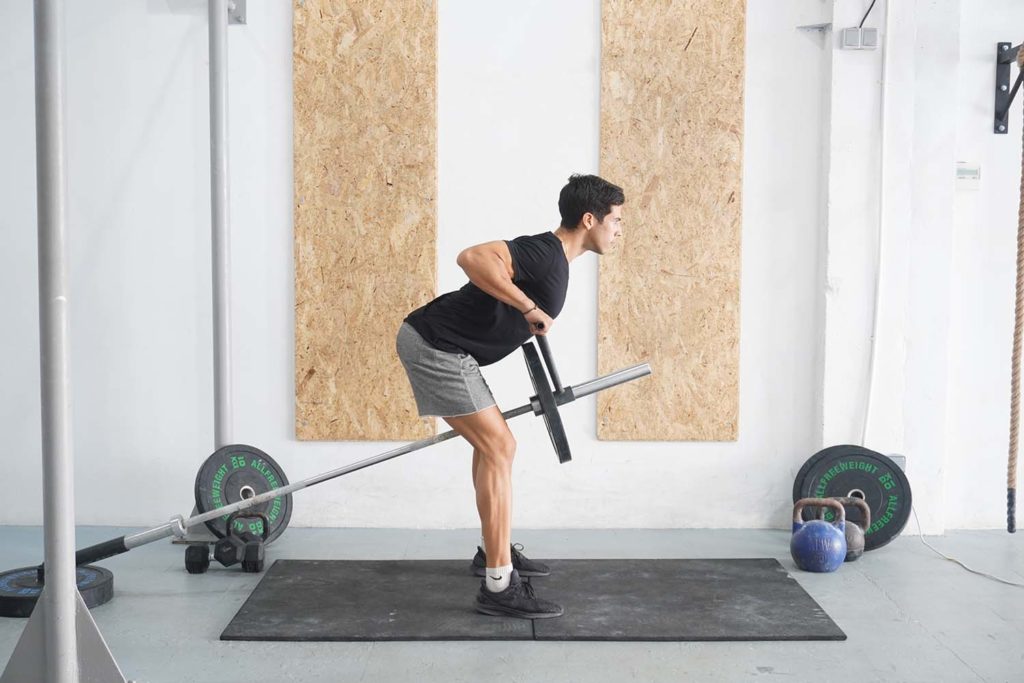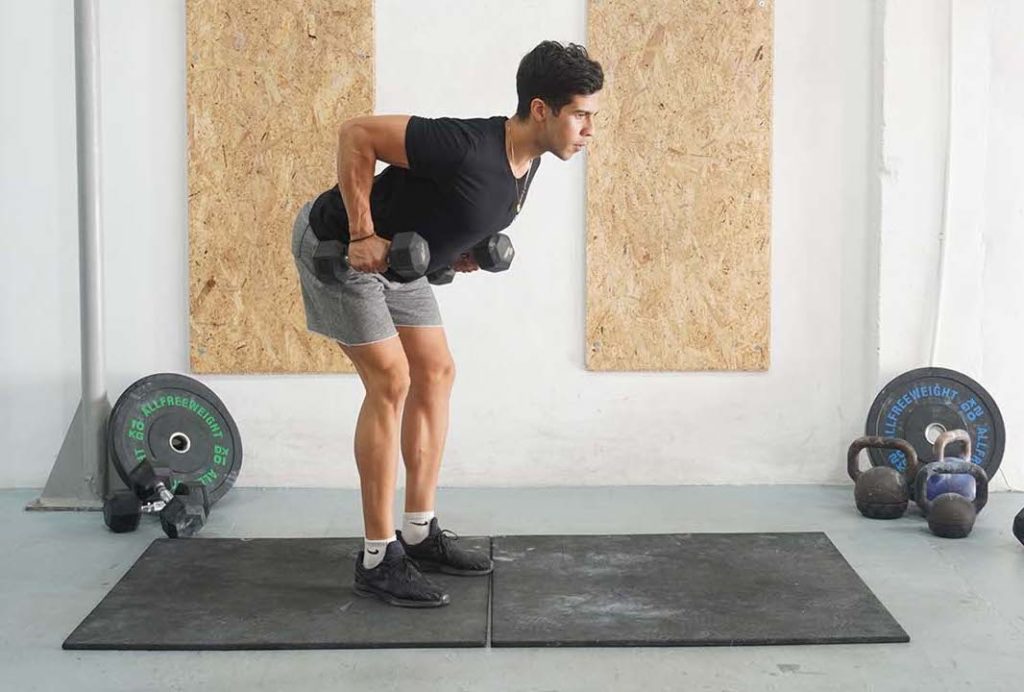The Benefits of the Pendlay Row
Pendlay rows are a popular and highly effective exercise that strengthens your back, midsection, shoulders, biceps, and grip.
Named after American weightlifting coach Glenn Pendlay, the row variation is one where you use a barbell. But, instead of bending forward and keeping the weight in the air until you’re done, you set it on the floor between repetitions. Doing so is beneficial for minimizing the stress on your lower back and reducing the risk of using momentum to row the weight.
A notable benefit of the Pendlay row is the excellent overload it causes. Like barbell rows, you can work up to respectable loads that promote mechanical tension, driving your back and biceps to grow (1).
Another advantage of Pendlay rows is that it helps improve your lifting form and get more out of your training. Unlike bent-over rows, the Pendlay variation forces you to lift the barbell in one smooth pull and prevents you from moving your torso up and down to generate momentum.
The third notable benefit of Pendlay rows is that the movement makes you highly functional and athletic. Rowing a barbell strengthens a range of major muscle groups in your body, builds whole-body strength, and improves your stability. As a result, everyday activities become easier, and your athletic performance improves.
Pendlay rows are excellent for everyone interested in building up their back and developing pulling strength that’s beneficial for other activities, like the pull-up and deadlift. The only people who should avoid Pendlay rows are those struggling with lower back pain that flares up from such movements.
We recommend including Pendlay rows early in your training and picking a weight that allows you to perform at least six to eight smooth repetitions. Beginners might even shoot for ten reps per set to ensure proper technique.
Level of Exercise: Beginner/Intermediate
How to do a Pendlay Row

- Load the barbell and position it on the floor and in front of you.
- Stand in front of the bar with your feet in a comfortable stance and toes pointing slightly out.
- Lean forward and bend your knees enough to grab the bar with a double overhand grip without moving or lifting it.
- Bring your shoulders back as much as possible to straighten your back. Your shoulders should be slightly in front of the barbell and higher than your hips. The starting position resembles conventional deadlifts, with the only difference being the small distance between your shins and the bar.
- Take a breath and row the barbell to your chest smoothly.
- Touch your torso with the bar, holding the top position for a moment, and release.
- Lower the barbell slowly and rest it on the floor as you exhale.
- Take another breath and row the barbell from a dead stop, pausing at the top.
- Repeat until you’re done.
What muscles does the barbell Pendlay row activate?
Pendlay rows are excellent for the entire back. The primary muscle group involved in the exercise is the latissimus dorsi––the largest muscle in the upper body.
Our lats cover a significant percentage of the back and contribute to numerous arm motions since they insert into the humerus (upper arm bone) (2). The muscle group produces force for us to row the barbell and continues to work as we lower the weight to the floor (3).
The trapezius, rhomboids, infraspinatus, and erector spinae also work during Pendlay rows. Each of these muscles promotes torso stability and helps us retract our shoulder blades and keep them in position as we row the weight. These muscles also play an active role in assisting the lats with pulling.
Our rear deltoids (a portion of the shoulder muscles) are also active during Pendlay rows. Your elbows are more tucked in, and you’re rowing the bar to your mid-stomach during bent-over rows. In contrast, a Pendlay row forces you to keep your elbows more flared and pull the barbell to the lower chest, leading to better activation in the upper back.
The biceps and brachialis also play a crucial role during Pendlay rows. Both muscles cover the front upper portion of our arms and produce elbow flexion (bending of the arms), which occurs as we pull the barbell (4, 5). Similarly, the brachioradialis, a muscle that covers the top of our forearms, assists with elbow flexion (6).
Aside from the muscles with an active role, the entire midsection musculature contributes during Pendlay rows. The abs, transverse abdominis, obliques, and other muscles flex isometrically to support the torso, allowing us to remain stable as we row.
Pendlay Row Vs. Barbell Row
Pendlay and barbell rows are similar, as both exercises train the same muscles. Both movements have similar overloading potentials, require the same equipment, and have identical ranges of motion.
The significant difference is that you set the barbell on the floor between reps during Pendlay rows but keep it in the air during bent-over rows. Pendlay rows are less demanding on your lower back, and you’re less likely to stop a set early due to fatigue. In contrast, bent-over rows tend to be more demanding because the bar has to stay several inches off the floor between reps, making you work extra hard.
Another difference between the two exercises is that you’re more likely to use momentum, jerk the weight, and shorten the range of motion during a bent-over row. For instance, you would lower the barbell and lean your torso forward, pull, and raise your torso, making the exercise easier.
Cheating is also possible during Pendlay rows, but you’re less likely to do so because the exercise forces you to assume the correct position as you set the bar on the floor between reps.
The third difference is the path the barbell travels relative to your torso. Your elbows are more tucked in during traditional rows, causing the barbell to travel to your mid-stomach. In contrast, Pendlay rows require a more significant elbow flare, causing the bar to travel to chest level as you pull.
The subtle difference between the two activities influences muscle activation, allowing Pendlay rows to emphasize your rear deltoids and trapezius slightly better.
Despite the differences, Pendlay and bent-over rows are similar in many ways, and either would deliver excellent results, so long as you pick the correct load, use proper form, and listen to your body. Traditional rows might not be helpful for people with lower back issues, whereas Pendlay rows could be challenging to do for people with tight hamstrings or hips.
Variations and Modifications of the Pendlay Row
1. Bent-Over Barbell Rows
Bent-over barbell rows are the most popular variation of Pendlay rows. The primary difference is that you must keep the barbell in the air between repetitions and set it on the floor after completing all reps. Doing the movement that way is more demanding for the lower back and might not be suitable for people struggling with pain in the area.
2. Elevated Pendlay Rows
Elevated Pendlay rows are a variation where you place the barbell on blocks or inside a rack to raise it several inches off the floor. Doing so is beneficial because it allows people with limited mobility to perform the exercise. You can also use more weight because the range of motion is shorter.
3. Deficit Pendlay Rows
Similar to a deficit deadlift, the objective is to elevate your feet by stepping on a weight plate or something similar. Doing so increases the movement’s range of motion, allowing you to stretch all involved muscles more effectively.
Remember that deficit Pendlay rows require excellent mobility, hamstring flexibility, and body awareness. Consider having a friend watch as you do the movement or film some of your sets to see how you look from the side.
4. Touch-And-Go Pendlay Rows
The touch-and-go Pendlay row is a fun variation that lets you get dynamic, lift heavy weights, and perform more repetitions. Instead of setting the bar on the floor between reps and pulling from a dead stop, you lower the weight, tap the floor, and pull it again.
The variation works well for using more weight and promoting overload, but you must be careful not to use too much momentum or let your back round during a set.
Mistakes to Avoid
Lifting too Much Weight
The most common mistake people make with Pendlay rows is lifting too much weight. Doing so forces you to use compensatory tactics, such as jerking the weight and shortening the range of motion. Any such ‘adjustment’ makes the exercise less effective and beneficial. Plus, using weights you cannot control puts you at a higher risk of injury.
You should start learning the exercise with a weight that allows you to perform at least ten smooth repetitions with a full range of motion. Grab the bar, brace your body, and pull the weight to your upper stomach in one fluid motion. Anything heavier would lead you to develop a poor motor pattern and get less out of the movement in the long run.
Using Momentum
The second common error with Pendlay rows is using too much momentum when pulling the barbell. Pendlay rows are more dynamic than bent-over rows because you must pull the weight from a dead stop. But, it doesn’t mean you should row with as much force as possible off the floor. Doing so might allow you to train with more weight, but it increases the risk of taking tension away from the correct muscles and forcing your biceps to do most of the work.
Another subtle way people use momentum during the activity is by changing their hip angle. Trainees would start with the bar on the floor, torso nearly parallel to the floor, and pull.
Their hips extend as the weight travels up, causing their torso to become somewhat upright, making it easier to row. Avoid the error by picking a load you can row smoothly and without having to extend your hips. Your torso should remain in the same position from start to finish.
Rounding Your Back
The third error with Pendlay rows is allowing your lower back to round. Trainees often lose their neutral spine position due to tight hamstrings that pull the pelvis down as they lean forward to grab the barbell. Stretching your hamstrings and working on hip mobility can help you assume the correct position for safe and effective rows.
Similar Exercises to the Pendlay row
Renegade Row

Renegade rows are a functional exercise that strengthens your glutes, midsection, shoulders, arms, and upper back. The objective is to assume a standard push-up position while supporting yourself on a pair of hexagonal dumbbells.
Once in place, you must tilt slightly to one side and row the opposite dumbbell. Like other rowing movements, the variation strengthens your lats and biceps, along with stabilizing muscles, such as the abs, obliques, and erector spinae.
T Bar Row

T-bar rows are a movement you perform on a T-bar machine. Alternatively, you can anchor one end of a barbell with a landmine attachment, load the other end, place a V handle underneath the bar, close to the sleeve, and row.
Both movement variations are fantastic and similar to Pendlay rows because of their identical range of motion and overloading capacity. T-bar rows are slightly more similar to bent-over rows because you’re not setting the weight on the floor between reps but must keep it in the air until you finish the set.
Bent Over Row (Dumbbell)

Bent-over dumbbell rows are a fantastic but less common exercise for strengthening your back. Dumbbells are beneficial because you can train through a slightly longer range of motion, overload your muscles effectively, and force both sides of your body to work independently. A notable advantage is that dumbbells reduce the risk of side-to-side muscle imbalances and can lead to better muscle activation.
Like a bent-over barbell row, the objective is to grab the weight, lean forward, and row. You can also perform the movement in a Pendlay style by setting the dumbbells on the floor between repetitions.

